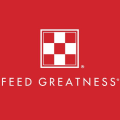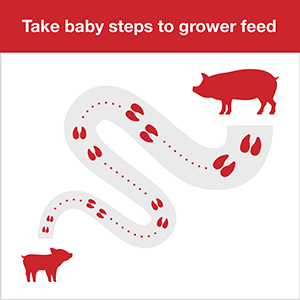
The first step in any successful fitness routine is to start small. The same can be said for successful weaned pig transitions. For example, if you’re new to running, your first step is not a marathon. It might not even be running. To start, you might need to get off the couch and go for a walk. Then, you will need to repeat this first step to give your body time to adjust.

Similarly, nursery pigs need time to adjust to new diets. It is important to keep this in mind if you feel pressure to cut costs due to escalating feed prices or deteriorating hog markets. These pressures can make feeding simple grain diets to your nursery pigs enticing compared to complex diets. But, the abrupt change from sow milk to simple feed ingredients could result in health challenges that outweigh the potential savings of cheaper diets.
Complexity beats simplicity for young pigs
“Complex diets are easy to digest and support a gradual transition from liquid milk to dry ingredients,” says Emily Otto-Tice, Ph.D., Purina Swine Technical Solutions. “When ingredients are easy to digest, pigs adjust more smoothly to eating from a feeder rather than nursing on the sow. Complex diets also support the development of the enzymes needed to better digest plant proteins and carbohydrates.”
Complex ingredients can have higher up-front costs than purchasing commodities for simple grain diets. However, complex ingredients are processed to provide higher nutrient quality and improved nutrient availability to the young pig. Therefore, they can pay off in improved feed intake and pig health in the nursery and beyond.
You have the best chance of success when you balance the short- and long-term potential returns. The good news is you can choose the level of diet complexity that works for your operation.
Small steps for strong starts

One strategy to optimize pig growth and performance is feeding a series of diets based on the pig’s age and nutritional needs, starting with highly complex diets and stepping down in complexity – and ingredient costs – as pigs grow. The performance benefits of precise phase feeding include early intake, strong starts and robust nursery pigs.
The challenges of precise phase feeding include multiple diet transitions and more complicated feed-handling logistics. For example, it can be difficult to ensure all pigs get adequate access to the phase 1 diet when barn loading takes several days or a couple of weeks. You might transition to your phase 2 diet when the youngest, smallest pigs have consumed very little or none of a phase 1 feed.
“A newly weaned pig might look like it’s ready to transition to a phase 2 diet after eating only 3 pounds of phase 1,” Otto-Tice says. “But, if that phase 1 diet is formulated for 6 pounds or more intake, it will be too early for the pig. On the inside, its gut is not mature enough to fully handle the reduced complexity of the ingredients.”
Fewer steps, longer strides
Some producers prefer a reduced number of phases in their nursery or starter programs for convenience and labor efficiency. For example, a producer could feed an alternative diet that is still complex but has a slightly lower plane of nutrition. This alternative diet meets the needs of traditional phase 1 and phase 2 nursery feeding programs and is fed for the first 7 to 10 days post weaning. Extending the phases allows producers to manage costs while ensuring all pigs get access to enough phase 1 feed and have smooth transitions to gut maturity.
“Pigs might not get the optimal starts in the first week they would from a more complex phase one diet,” Otto-Tice says. “But, this feeding strategy approach still supports the transition from sow milk to dry feed and is much smoother than an abrupt switch from milk to grains and other protein sources. An extended phase 1 also provides the correct nutrition for gut development and allows more time for the gut to mature and develop the proper enzymes to digest plant ingredients.”
Time is important because it takes at least four days for the complete turnover of the cells that make up the lining of the small intestine, where nutrient absorption occurs.[1] Enzyme development happens in the lining of the pig’s gut along finger-like structures called villi. New intestinal lining cells form at the base of the villus and travel up its length, where the cellular functions differentiate. Some of these new cells will create digestive enzymes to handle the new feed ingredients as diet composition changes.

End of nursery weights predict finishing weights
Each performance phase impacts the next, and end-of-nursery weights are the strongest predictor of finishing weights. For every 1-pound increase on day 32 post-weaning weights, data shows an increase of 2.1 pounds on finishing weights (110 d).[2]
You can support optimal pig performance in the grower and finisher phases by choosing ingredients to ease the weaned pig’s transition from sow milk to dry feed.
“Each operation is different, and individuals need to decide based on their unique goals whether it makes sense to feed multiple nursery diets with complex ingredients or utilize diets with a little less complexity that maintain a high degree of digestibility and palatability and require fewer phases,” Otto-Tice says.
[1] Moon, Harley W. 1971. Proceedings of the Society for Experimental Biology and Medicine, Volume: 137 issue: 1, page(s): 151-154
[2] Summation of Purina Animal Nutrition trials: PS1041, PS1035, WF006, WF007, FT142N-15 and PMI Nursery-Grower Transition Pak research (slide 17 in R+D Data for PtoP)
May 11, 2021 - Purina Animal Nutrition LLC




